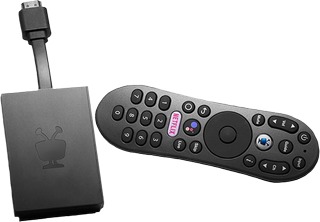TiVo Stream 4K vs. Roku Streaming Stick+
TiVo Stream 4K

TiVo Stream 4K is a sub-$50 Android TV dongle that ticks all the specs boxes you want. It's got 4K resolution, Dolby Vision and HDR10. It's got Dolby Atmos. And it has all the Android TV stuff you want. Plus it has some special TiVo sauce baked in, with special integration for Sling TV.
TiVo Stream 4K
Roku Streaming Stick+

The Roku Streaming Stick+ has all the features you want, in a platform that's easy to use. It lacks some extra bells and whistles of Roku Ultra, but it's also less expensive. And the only major spec it's missing is Dolby Vision.
Roku Streaming Stick+
Two $49 streaming dongles (OK, one technically is a stick), very much alike in virtue. They're pretty close in terms of specs, but one definitely stands out above the other thanks to a couple options.
Roku Streaming Stick+? Or the TiVo Stream 4K?
Look at the Roku Streaming Stick+ and the TiVo Stream 4K side by side, and a few things stand out. First is the price — both come in at $49. So that's easy. The processors are basically the same, too. (Roku just doesn't list the manufacturer anywhere, but they're both quad-core ARM Cortex A53.)
Then things start to diverge a bit. Roku doesn't list on-board storage — which for the most part is just fine. It doesn't really treat it's "channels" as apps (even though that's exactly what they are). And it's probably not anything that'll ever be an issue to you anyway.
The bigger deal is that Roku doesn't yet support Dolby Vision or Dolby Atmos. The former remains more important, as Dolby Vision (a proprietary form of HDR) is more readily available in televisions than Atmos is in audio equipment.
There's also the small matter of power cords. The TiVo stream can be powered by microUSB, or USB-C. The Roku Streaming Stick+ requires you to use the included power cable, which also has a Wifi antenna built into it. That's not a deal-breaker by any stretch of the imagination — it's just something different between the two devices is all.
Get the What to Watch Newsletter
The latest updates, reviews and unmissable series to watch and more!
| Header Cell - Column 0 | Roku Streaming Stick+ | TiVo Stream 4K |
|---|---|---|
| Price | $49 | $49 |
| Operating system | Roku OS | Android 9 |
| Processor | Quad-core ARM Cortex A53 | Amlogic S905Y2 |
| Storage | NA | 8GB |
| RAM | 1 GB | 2 GB |
| Wifi | 802.11ac | 802.11ac |
| Dolby Vision | No | Yes |
| Dolby Atmos | No | Yes |
| HDR10 | Yes | Yes |
| Voice remote | Yes | Yes |
| App Store | Roku Channel Store | Google Play |
| Chromecast | Yes | Yes |
| AirPlay | No | No |
The other major difference, of course, is in ecosystem. And this really comes down to matter of preference.
Android TV is much more powerful and customizable. You've got the full depth of the Google Play Store available (what's available for Android TV, anyway). That includes streaming apps, utilities, screensavers, music and games, for starters. Roku has a lot of that, too. But you'll quickly find yourself in the dregs, with apps looking more like spam than anything you'd want to bother installing.
I would argue that the biggest difference between the two platforms, though, is one of ease. Roku is just simpler to use. It takes fewer clicks to get to what you want. The home screen is less cluttered.
